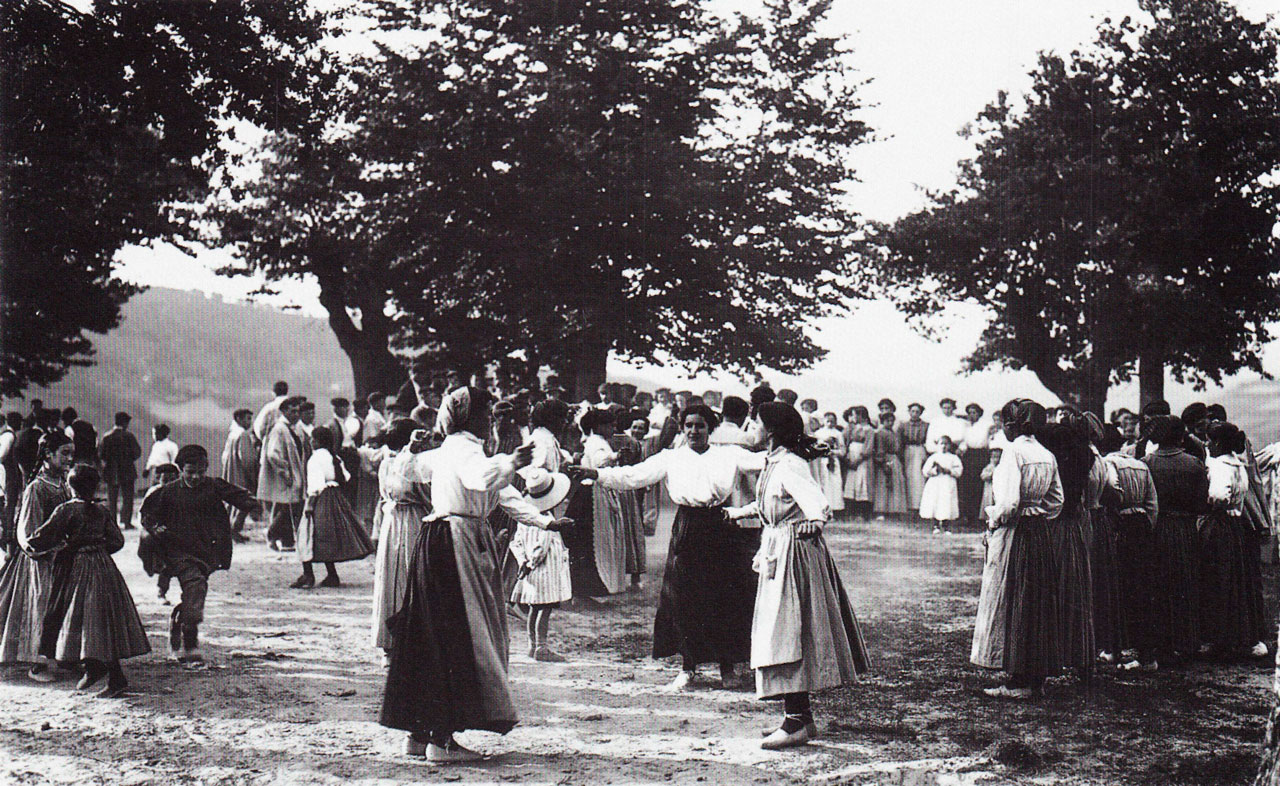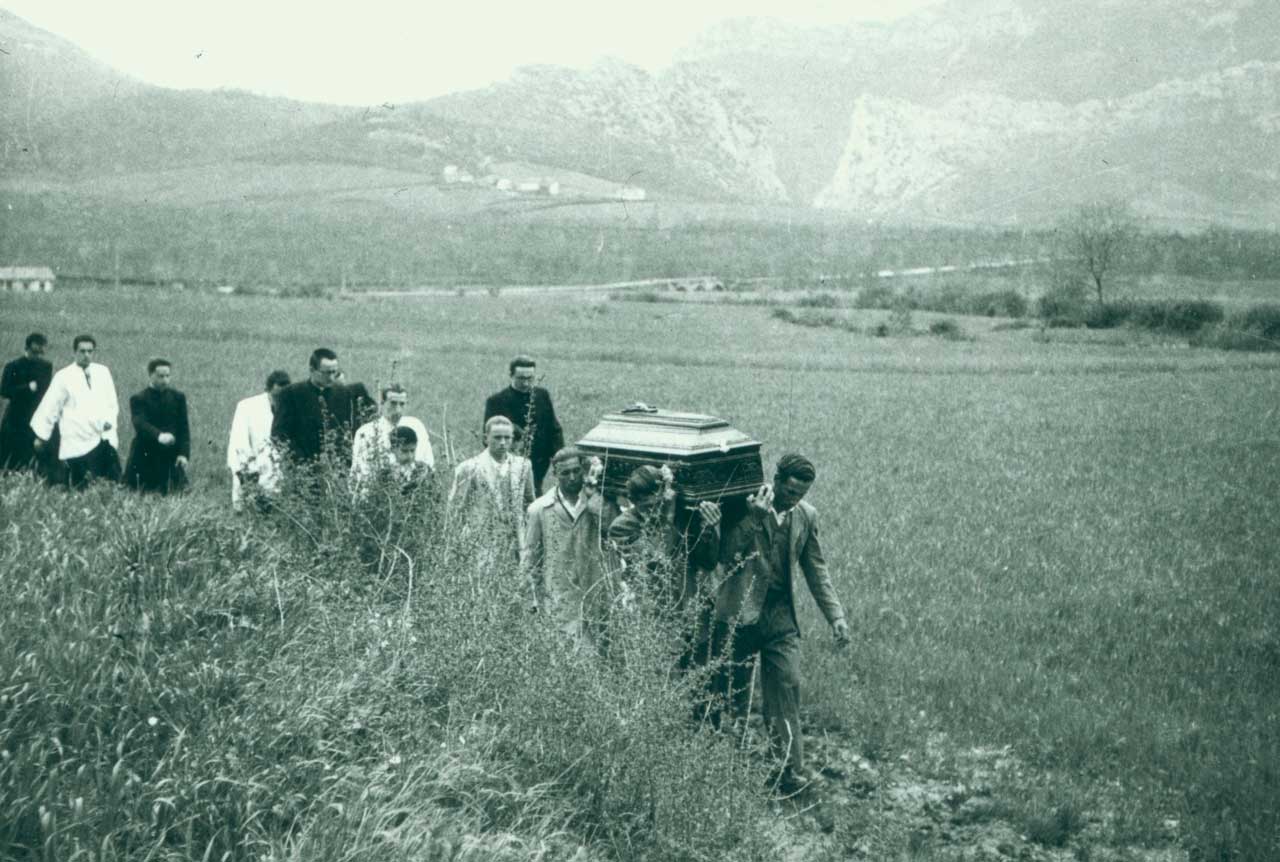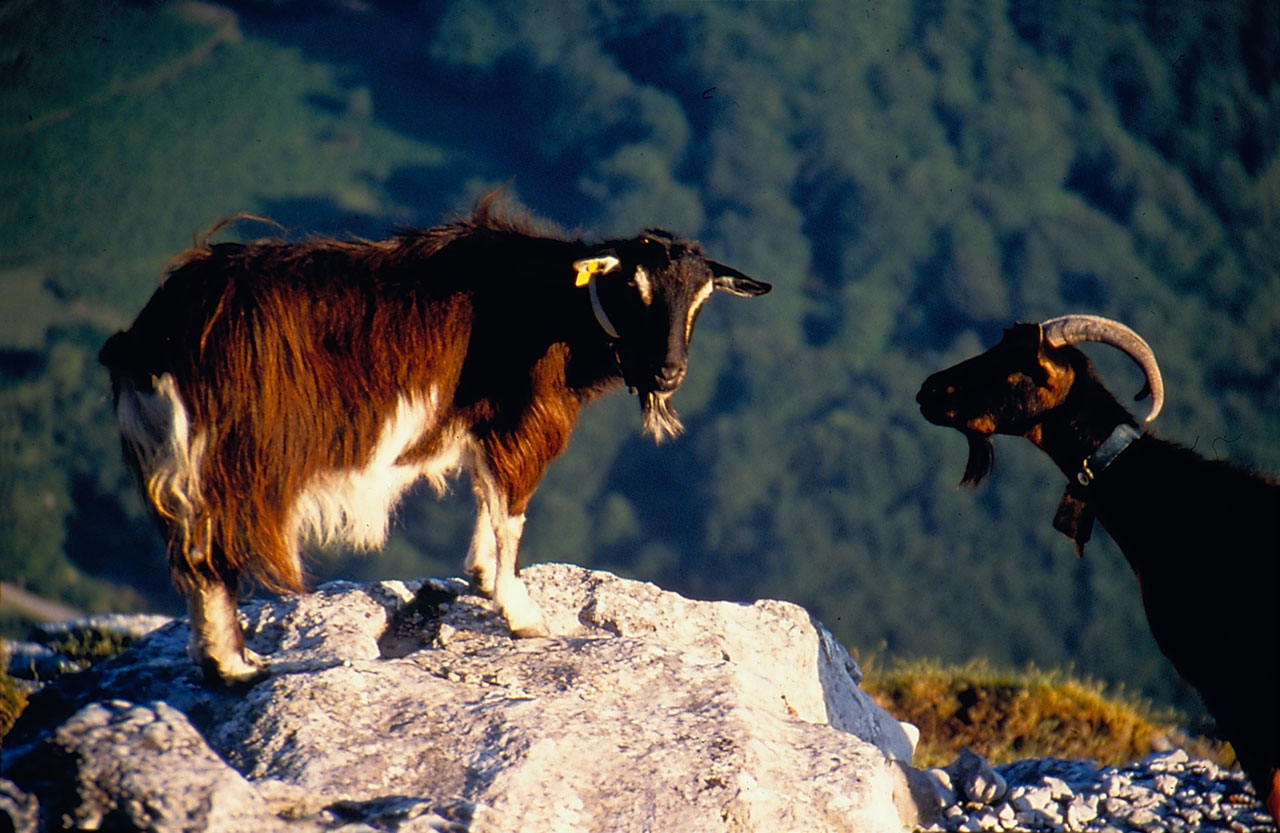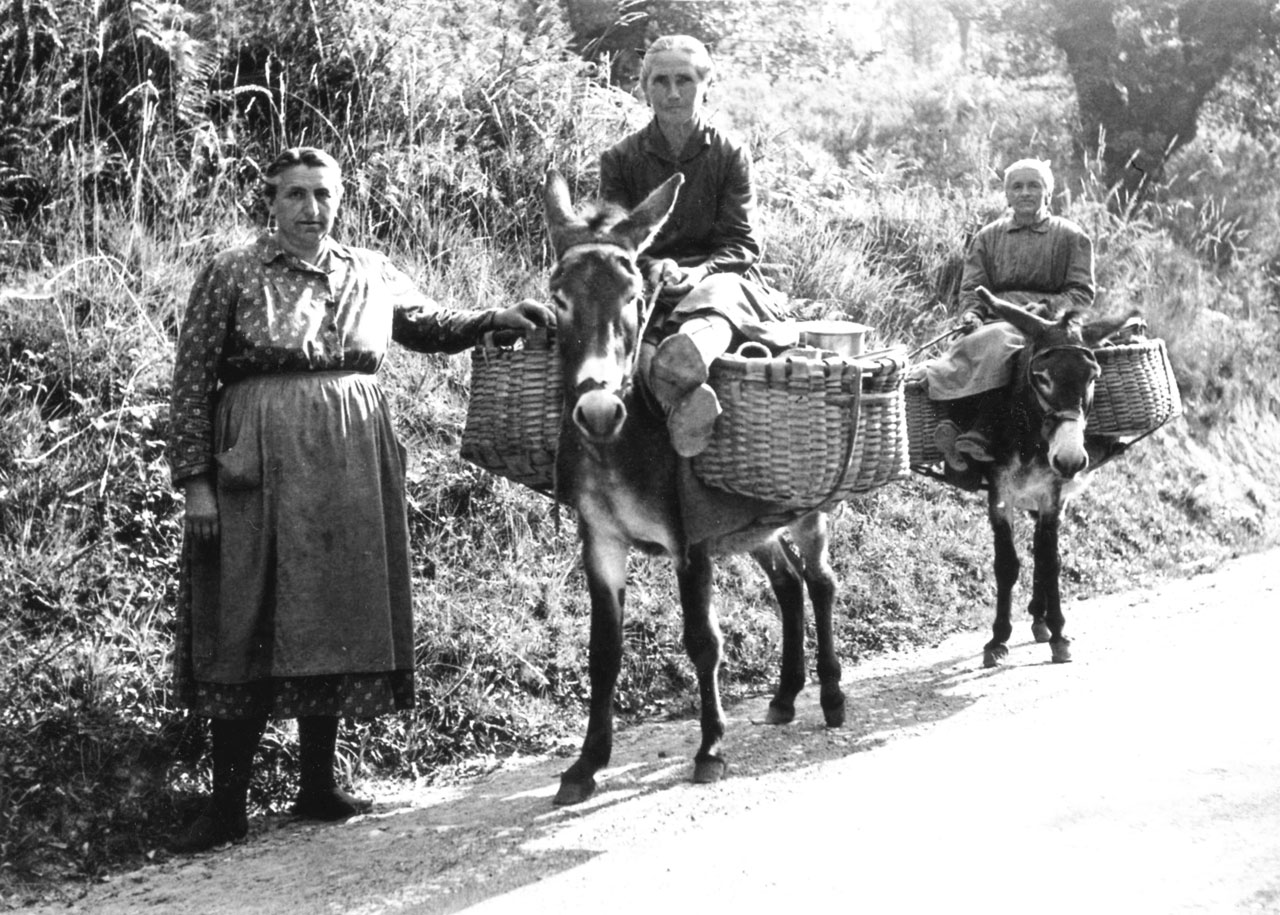Diferencia entre revisiones de «Main Page/en»
De Atlas Etnográfico de Vasconia
| Línea 218: | Línea 218: | ||
====[/atlas/ganaderia/Pastando-en-Eneabe-Zeanuri-1996.jpg|Grazing in Eneabe. Zeanuri (B), 1996. Source: Labayru Fundazioa Photograhic Archive: José Ignacio García Muñoz.|Two millennia ago Pliny distinguished Vasconum saltus, humid and wooded, from Vasconum ager, with its grain fields and vineyards. That distinction still remains today, with regard to livestock farming.|]==== | ====[/atlas/ganaderia/Pastando-en-Eneabe-Zeanuri-1996.jpg|Grazing in Eneabe. Zeanuri (B), 1996. Source: Labayru Fundazioa Photograhic Archive: José Ignacio García Muñoz.|Two millennia ago Pliny distinguished Vasconum saltus, humid and wooded, from Vasconum ager, with its grain fields and vineyards. That distinction still remains today, with regard to livestock farming.|]==== | ||
| − | ====[/atlas/ganaderia/Pastor-de-Lanciego-subiendo-a-Tolono-1996.jpg|Shepherd from Lanciego (A) on the climb to Toloño, 1996. Source: José Ángel Chasco, Etniker Euskalerria Groups.|The Mediterranean watershed of the Basque Country was, and to a large extent is, characterized by the importance of the commons, the communal character of their exploitation by associations and brotherhoods comprising multiple municipalities still persisting today.|| | + | ====[/atlas/ganaderia/Pastor-de-Lanciego-subiendo-a-Tolono-1996.jpg|Shepherd from Lanciego (A) on the climb to Toloño, 1996. Source: José Ángel Chasco, Etniker Euskalerria Groups.|The Mediterranean watershed of the Basque Country was, and to a large extent is, characterized by the importance of the commons, the communal character of their exploitation by associations and brotherhoods comprising multiple municipalities still persisting today.||]==== |
| − | ====[/atlas/ganaderia/Establo-de-ovejas-moderno-Izurtza-2000.jpg|Modern stable for sheep. Izurtza (B), 2000. Source: Labayru Fundazioa Photograhic Archive: José Ignacio García Muñoz.|The transformations that have taken place in the last few decades have fundamentally changed the world of livestock farming: no longer a way of life, it is now an economic activity.|| | + | ====[/atlas/ganaderia/Establo-de-ovejas-moderno-Izurtza-2000.jpg|Modern stable for sheep. Izurtza (B), 2000. Source: Labayru Fundazioa Photograhic Archive: José Ignacio García Muñoz.|The transformations that have taken place in the last few decades have fundamentally changed the world of livestock farming: no longer a way of life, it is now an economic activity.||]==== |
| − | ====[/atlas/ganaderia/Oveja-negra-en-el-rebano-Meaga-Getaria.jpg|Black sheep in the flock. Meaga, Getaria (G). Source: Antxon Aguirre, Etniker Euskalerria Groups.|A black animal, and particularly a billy goat, was considered to protect the herd, flock or barn throughout the area surveyed.|| | + | ====[/atlas/ganaderia/Oveja-negra-en-el-rebano-Meaga-Getaria.jpg|Black sheep in the flock. Meaga, Getaria (G). Source: Antxon Aguirre, Etniker Euskalerria Groups.|A black animal, and particularly a billy goat, was considered to protect the herd, flock or barn throughout the area surveyed.||]==== |
| − | ====[/atlas/ganaderia/Cabras-con-cencerros-Anboto-1999.jpg|Goats wearing bells. Anboto (B), 1999. Source: Labayru Fundazioa Photograhic Archive: José Ignacio García Muñoz.|Cowbells, in the same way as chimes, have been attributed with the power to protect the livestock from spells. Their use to protect against the evil eye, begizkoa, was very widespread in the past.|| | + | ====[/atlas/ganaderia/Cabras-con-cencerros-Anboto-1999.jpg|Goats wearing bells. Anboto (B), 1999. Source: Labayru Fundazioa Photograhic Archive: José Ignacio García Muñoz.|Cowbells, in the same way as chimes, have been attributed with the power to protect the livestock from spells. Their use to protect against the evil eye, begizkoa, was very widespread in the past.||]==== |
| − | ====[/atlas/ganaderia/Pastor-con-kapusai-Eriete-1959.jpg|Shepherd wearing a cape. Eriete (N), 1959. Source: Archive of the Museum of Navarre: Nicolás Ardanaz Collection.|Nolako artzaina, halako artaldea. <br />''Every animal ends up looking like their master.''|| | + | ====[/atlas/ganaderia/Pastor-con-kapusai-Eriete-1959.jpg|Shepherd wearing a cape. Eriete (N), 1959. Source: Archive of the Museum of Navarre: Nicolás Ardanaz Collection.|Nolako artzaina, halako artaldea. <br />''Every animal ends up looking like their master.''||]==== |
| − | ====[/atlas/ganaderia/Bendicion-del-rebano-antes-de-la-partida.jpg|Blessing of the flock before departure. Source: Antxon Aguirre, Etniker Euskalerria Groups.|Artaldearentzat artzain guti hobe ainitz baino. <br />''Too many cooks spoil the broth.''|| | + | ====[/atlas/ganaderia/Bendicion-del-rebano-antes-de-la-partida.jpg|Blessing of the flock before departure. Source: Antxon Aguirre, Etniker Euskalerria Groups.|Artaldearentzat artzain guti hobe ainitz baino. <br />''Too many cooks spoil the broth.''||]==== |
| − | ====[/atlas/ganaderia/Esquilando-ovejas-por-el-sistema-tradicional-Carranza-1998.jpg|Traditional sheep shearing. Carranza (B), 1998. Source: Miguel Sabino Díaz, Etniker Euskalerria Groups.|Grullas p’arriba, pastor buena vida, <br />Grullas p’abajo, pastor más trabajo.<br /><br />''When cranes fly north, life is easier for shepherds, <br />when they fly south, work is harder for shepherds.''|| | + | ====[/atlas/ganaderia/Esquilando-ovejas-por-el-sistema-tradicional-Carranza-1998.jpg|Traditional sheep shearing. Carranza (B), 1998. Source: Miguel Sabino Díaz, Etniker Euskalerria Groups.|Grullas p’arriba, pastor buena vida, <br />Grullas p’abajo, pastor más trabajo.<br /><br />''When cranes fly north, life is easier for shepherds, <br />when they fly south, work is harder for shepherds.''||]==== |
| − | ====[/atlas/ganaderia/Subida-al-monte-Aia-1998.jpg|Climb to the mountain. Aia (G), 1998. Source: Antxon Aguirre, Etniker Euskalerria Groups.|At the end of the Middle Ages, flocks in the Basque valleys converged on the same mountains that are now the main summer grassland used for grazing.|| | + | ====[/atlas/ganaderia/Subida-al-monte-Aia-1998.jpg|Climb to the mountain. Aia (G), 1998. Source: Antxon Aguirre, Etniker Euskalerria Groups.|At the end of the Middle Ages, flocks in the Basque valleys converged on the same mountains that are now the main summer grassland used for grazing.||]==== |
| − | ====[/atlas/ganaderia/Dolmen-de-Gaxteenia-Mendibe-1980.jpg|Dolmen of Gaxteenia. Mendibe (NB), 1980. Source: Blot, Jacques. Artzainak. Les bergers basques. Los pastores vascos. Donostia: Elkar, 1984.|“The axial zone of the Basque Pyrenees retains underneath a maze of folds traits of a time-honoured culture.” <br />''J. M. Barandiaran''|| | + | ====[/atlas/ganaderia/Dolmen-de-Gaxteenia-Mendibe-1980.jpg|Dolmen of Gaxteenia. Mendibe (NB), 1980. Source: Blot, Jacques. Artzainak. Les bergers basques. Los pastores vascos. Donostia: Elkar, 1984.|“The axial zone of the Basque Pyrenees retains underneath a maze of folds traits of a time-honoured culture.” <br />''J. M. Barandiaran''||]==== |
| − | ====[/atlas/ganaderia/Pastos-en-Carranza-2009.jpg|Grassy pastures in Carranza (B), 2009. Source: Luis Manuel Peña, Etniker Euskalerria Groups.|The priority of the right of herds to cross arable land is expressed in the sentence: ''soroak zor dio larreari'' ‘arable land is indebted to grassland’.|| | + | ====[/atlas/ganaderia/Pastos-en-Carranza-2009.jpg|Grassy pastures in Carranza (B), 2009. Source: Luis Manuel Peña, Etniker Euskalerria Groups.|The priority of the right of herds to cross arable land is expressed in the sentence: ''soroak zor dio larreari'' ‘arable land is indebted to grassland’.||]==== |
| − | ====[/atlas/ganaderia/Vacas-en-prados-comunales-Carranza-2007.jpg|Cattle on common pastures. Carranza (B), 2007. Source: Luis Manuel Peña, Etniker Euskalerria Groups.|Communities in areas where livestock has been the fundamental basis of their way of life consider Saint Anthony Abbot as the main protector of the health and fertility of the animals.|| | + | ====[/atlas/ganaderia/Vacas-en-prados-comunales-Carranza-2007.jpg|Cattle on common pastures. Carranza (B), 2007. Source: Luis Manuel Peña, Etniker Euskalerria Groups.|Communities in areas where livestock has been the fundamental basis of their way of life consider Saint Anthony Abbot as the main protector of the health and fertility of the animals.||]==== |
| − | ====[/atlas/ganaderia/Pastor-y-espaldero-Canada-de-los-Roncaleses-1996.jpg|Herder and dog. Droveway of the Roncalese (N), 1996. Source: Iñaki San Miguel, Etniker Euskalerria Groups.|The introduction of sheepdogs meant they replaced the zagales, young children who had been in charge of herding the flock up to then.|| | + | ====[/atlas/ganaderia/Pastor-y-espaldero-Canada-de-los-Roncaleses-1996.jpg|Herder and dog. Droveway of the Roncalese (N), 1996. Source: Iñaki San Miguel, Etniker Euskalerria Groups.|The introduction of sheepdogs meant they replaced the zagales, young children who had been in charge of herding the flock up to then.||]==== |
Revisión del 15:02 10 feb 2020
Cooking on the hearth. Apellániz (A), 1981. Source: López de Guereñu, Gerardo. “Apellániz. Pasado y presente de un pueblo alavés” in Ohitura 0, Vitoria-Gasteiz: Chartered Government of Álava, 1981.
House and Family in the Basque Country


House and Family in the Basque Country
The kitchen in the farmsteads was where people would usually gather together and was at the heart of family life.
Family Diet in the Basque Country


Family Diet in the Basque Country
Maize, introduced in the 17th century, and potatoes, in the 19th, would revolutionise the Basque diet.
Children’s Games in the Basque Country


Children’s Games in the Basque Country
Korruka Al corro de las patatas, naranjas y limones, como comen los señores, alupé, alupé, sentadito me quedé.
Traditional Medicine in the Basque Country


Traditional Medicine in the Basque Country
Osasuna galtzen duenak dena galtzen du. If you don’t have your health, you don’t have anything.
Dancing during patronal celebrations. Zeanuri (B), 1922. Source: Labayru Fundazioa Photograhic Archive: Felipe Manterola Collection.
Rites from Birth to Marriage in the Basque Country


Rites from Birth to Marriage in the Basque Country
Young men and women would meet during the Sunday stroll, dances and pilgrimages.
Funeral Rites in the Basque Country


Funeral Rites in the Basque Country
Dying on a rainy day or if it rained after the death showed that the soul would be saved: gorputz ona, euritsu.
Goats wearing bells. Anboto (B), 1999. Source: Labayru Fundazioa Photograhic Archive: José Ignacio García Muñoz.
Livestock Farming and Shepherding in the Basque Country


Livestock Farming and Shepherding in the Basque Country
Cowbells, in the same way as chimes, have been attributed with the power to protect the livestock from spells. Their use to protect against the evil eye, begizkoa, was very widespread in the past.
Agriculture in the Basque Country


Agriculture in the Basque Country
Our rural folk and our ancestors knew and practised agriculture on a more human scale and from a more holistic approach; it is not only the yield that matters, but also the complex network of physical factors and human beings involved in an activity that is actually based on cultivating the life that feeds us.








